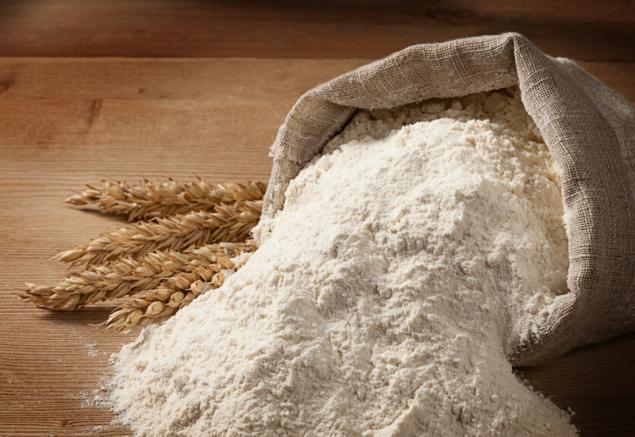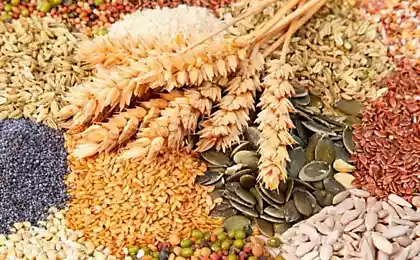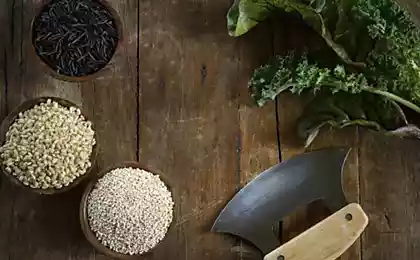583
So any useful grits?
Plant seeds, in addition to familiar to us nutrients, contain substances that prevent germination. When the seeds fall in the right conditions (moisture and warmth), these substances neutraliseerida, releases minerals, increasing the amount of vitamins, enzymes start to break down proteins, fats and carbohydrates, the plant begins growth and nutrition.

But the fact that these anti-nutritional substances also hinder the absorption of plant foods by animals. We can say that with the help of anti-nutritional seeds are "protected" from eating animals. The antinutrients contained in the shell of grains, legumes, nuts, seeds, other plant seeds. In legumes they are also distributed throughout the volume of the seeds.
Characterization of anti-nutritional
1
Phytic acid
Phytic acid prevents the absorption of phosphorus, iron, magnesium, calcium, zinc. And it concerns not only the minerals in the grain and minerals from other foods eaten with the grain. According to some studies, after the removal of phytic acid, iron absorption is increased in 12 times. Regular consumption of foods rich in phytic acid causes mineral deficiencies, tooth decay, osteoporosis.
2
Enzyme inhibitors
Enzyme inhibitors do not allow the seeds to germinate in adverse conditions. When eating seeds, they are associated with the digestive human enzymes, preventing digestion of food. Impact of the large intestine of undigested food particles mentioned above (the development of pathogenic organisms, poisoning the body with toxins, allergies, flatulence). Phytic acid also interferes with some digestive enzymes.
3
Lectins
Lectins — proteins that can attach to other cells or substances (agglutination — bonding and the precipitation). Most lectins found in the seeds of plants, especially in legumes. In the human body alien lectins can cause damage to the walls of the intestine, allergic and autoimmune diseases, destruction of red blood cells and leukocytes, to interfere with the digestion of food.
Neutralization of anti-nutritional
Plant seeds - food for the birds. In birds there is a special extended part of the esophagus (goiter), one function of which is the preliminary processing of food. In craw grain get soaked and fermented before you can get into the stomach.
In humans, such device is not, therefore, our ancestors practiced these treatments (soaking, germination or fermentation) before heat treatment of grain. The easiest way to remove some of the antinutrients from seed - to physically remove the shell. The flour can be sifted, nuts - soak for a day and peel.

In the matter of the cleansing of the flour from the bran there is a dilemma. On the one hand, the bran contain vitamins, minerals, and fiber in the flour them a little. Besides, refined flour has a high glycemic index. On the other hand, the bran contain anti-nutritional, and the easiest way to get rid of them — thoroughly sift the flour.
Traditional peoples used as whole grain and sifted flour for making bread. But sifted flour is not the same as flour or even 2nd grade. Technology that allowed enough to clear the flour did not exist before the late NINETEENTH century In sifted through a common sieve flour remain small pieces of the bran color, it almost does not differ from whole grain. Probably the best option is screening, which removes 20-25% of the total weight of flour in the form of bran with further fermentation (see table. below) and heat treatment.
Methods of neutralization of anti-nutritional
1
Soaking
Soaking the seeds is the easiest but not the most effective method of neutralizing the antinutrients. Getting into a wet environment, the grain begins to prepare for germination. The enzymes contained in it, aktiviziruyutsya and eliminate part of the phytic acid and enzyme inhibitors. Changes the structure of gluten, it becomes more digestible. To obtain the effect, the seeds should be soaked in warm water at least overnight, and longer. The degree of neutralization of phytic acid depends on the temperature, duration of steeping and content in grain of enzyme that destroys the phytase. Soak cereal does not make sense — in the thermal processing of the plant enzymes (including phytase) were destroyed, and the antinutrients remain. So oatmeal is not as healthy as many think. Soaked grains cook faster than dry, and requires 25% less water. In order to obtain the effect of the soaking, the grain is not necessarily whole. You can even soak the flour — leaving the dough overnight, you will significantly improve its nutritional value and safety.
2
Germination
A more effective method of neutralization of anti-nutritional — germination. Germination in the grain extends all the process that began when soaking. However, even sprouting insufficiently neutralizes the antinutrients, especially lectins. The sprouted grain will require further heat treatment. Of course, the seeds of plants that are consumed raw (nuts, seeds, sesame seeds) germinated much more valuable. Sprouting seed "awakens" the enzymes, increases the amounts of vitamins, releases minerals. Sprouted grain can be fed and poultry, resulting in more valuable food for the same money.
3
Fermentation
= soaking
+ sourdough
The most effective method of neutralizing the antinutrients. Fermentation (fermentation) — an ancient method of processing grains and legumes, which was used on all continents, which consume the grain. Fermented grain to cook faster than soaked, and requires less water. Lactic acid bacteria starter culture in a favorable temperature (30-35°C) and sufficient duration of fermentation (12-24 hours) eliminate almost all phytic acid. Accurate data about the influence of sourdough on lectins is not met, these questions are little researched. Most of our ancestors used fermentation as a method of preliminary processing of seeds. People with hypersensitivity of the organism (for example, Vladimir Togoev), confirm that the sourdough bread — the ideal form of consumption of grains. The sourdough bread should be sour (lactic acid — the result of activity of lactic acid bacteria).
The Internet is easy to find recipes sourdough from rye flour, but they have disadvantages. To prepare this "eternal" leaven you need to follow some rules:
The rest of the recipe starter standard. You need to take, for example, 3 tablespoons of flour, add warm water to desired consistency, loosely cover the container lid and place in a warm place. Next 4 days you need to repeat the same. After the fifth day you can make the first bread, using half of the starter. The dough needs to ripen for at least 8 hours in a warm place. The other half is covered loosely with a lid and put in the fridge.
About once a week the starter should be fed — to get out of the fridge, leave for half an hour at room temperature. Continue adding flour to the amount of starter has doubled (in our example 7-8 tablespoons), put on the day (or night) in a warm place. Again take half of the sourdough bread, the rest to hide in the refrigerator.
Rye sourdough contains not only lactic acid bacteria but also a large number of phytase. This yeast can use for fermentation of any of grain, legumes and other seeds. You need to fill the grain with warm water, add a teaspoon (or more) of the starter culture, stir, and put in a warm place for a day/night. The larger the seeds, the more time they need to ferment.
Even flour requires fermentation or soaking, since it contains a lot of gluten. Vitamin C not only neutralize the antinutrients in grain, process the lactose in the milk, but also enrich the product with vitamins. Therefore, sauerkraut has more vitamin C than fresh.published
Characteristics of cereals, legumes, other plant seeds
1
Buckwheat
Buckwheat is one of the best cereals for human nutrition with a very valuable protein (compared to other cereals). Even raw foodists Valentin Nikolaev sometimes uses cooked buckwheat when there is nothing raw. Buckwheat contains a lot of phytase, but soak brown (roasted) buckwheat no sense, since phytase has been destroyed. Soak or sprout can green buckwheat.
2
Figure
In comparison with other grain, in rice, a high indicator value protein. Polished (white) rice contain little phytic acid, few vitamins and minerals, has a high glycemic index. KI-unpolished (brown) rice is much lower content of vitamins and minerals above, but in its shell high content of phytic acid and other antinutrients. The study shows that the antinutrients in brown rice reduce the mineral content, and ultimately the absorption of minerals the same as from white rice. So you can use either white rice with fats and proteins, either pre-fermented for a few days of brown rice. Also note that in Asia use massive amounts of pesticides, so it is better not to eat rice grown in this region.
3
Rye
Rye contains protein of high value (like grain) and a large number of phytase. So rye sourdough is particularly effective to neutralize the phytic acid. Traditional grain dish in Kievan Rus was just rye bread. The bread is best done from freshly ground flour, or use a compromise variant — to buy rye flour. Of flour flour and remove 15% of bran by weight.
4
Wheat
Protein value of wheat depends on the variety and form (spring/winter), but the average figure is low. The content of phytase in the wheat is high, but less than rye. In other grain phytase a bit. In wheat, many gluten (especially modern varieties), gluten is also found in oats, barley and rye. Therefore, the use of wheat, without prior fermentation, or at least soaking is undesirable. Modern wheat varieties are significantly different from those used by our ancestors. Better to use the ancient wheat — spelt, spelt, or Kamut odnoselchanka. The Protocol for the treatment of senile dementia, it is recommended to exclude from the diet of wheat products, as they can run neirolepticalkie processes. During long-term storage flour wholemeal progorkaet Pufas contained in the seed. Flour is stored for a long time because there's almost nothing to spoil. It is low in vitamins and other nutrients.
5
Oats
Oats, the traditional culture of the Scots with high value protein. Nowadays the main product of the oats are cereals. Oatmeal, and cereals of other cereals — not very useful product. In the manufacture of cereal destroyed phytase and phytic acid remains, also used some chemicals. In the Soviet Union on the packaging of Hercules wrote that the flakes need to be soaked overnight before heat treatment. Although without phytase and other enzymes soaking still will not give the desired result. If it is possible to get the hulless oats (without chaff), it is better to grind on the mini mill to weed out a large part of the bran and baking sourdough bread.
6
Barley
Barley contains protein good value. Bread made from barley flour, quickly hardens and crumbles, so it is best used as a Supplement to wheat, rye or osanobu bread.
7
Millet
Protein value of millet is low, as wheat, so it is best consumed together with animal protein. Fermented for a day millet quick to cook (10-15 min) and has a different taste.
8
Corn
Maize protein is probably the worst of all grains. In Latin America, where the culture is traditional, before the heat treatment, the corn was fermented for a few days. This is not surprising because corn contains a lot of phytic acid and other antinutrients. If using corn, be sure and fermented along with animal proteins. From eating popcorn and regular corn porridge should be abandoned.
9
Quinoa, amaranth
Quinoa and amaranth — a South American relatives of quinoa. Quinoa seeds are highly valued in South America, but for us is expensive.
10
Legumes
There is a myth that protein of all legumes is a full replacement of animal proteins. In fact, the high value of the protein of chickpeas and soybeans. Moreover, because of the abundance of phytoestrogens soy is better not to get involved. The proteins of buckwheat, rice, oats, and rye is more valuable than other legumes. Most legumes contain a lot of phytic acid and other antinutrients, but because larger sizes are difficult fermentation. So in ancient recipes of different peoples of the legumes are first germinated and then fermented for a few days. Of beans should pay attention to the nut (a valuable protein, a little phytic acid), lentils, mung beans (small size, little phytic acid).
11
Nuts
Before use, the nuts need to soak for a day or two and remove the skin that contains anti-nutritional. When choosing nuts to take account of their LCD lineup. For example, a good option is the walnut, which has a lot of oleic acid.
12
Sesame seeds, flax seeds, other plants
Although the sesame seeds and flax seeds a lot of phytic acid, they are not consumed in large quantities. For any seed you can use the standard method of neutralization of anti-nutritional — fermentation for a day. Even for sprouted seeds which are not used in their raw form, need heat treatment.
The salt: detoxifies, helps with arthritis, muscle aches and spasms
7 simple ways to get rid of toxins in the body
Source: infohealth.jimdo.com/%D1%80%D0%B5%D0%BA%D0%BE%D0%BC%D0%B5%D0%BD%D0%B4%D0%B0%D1%86%D0%B8%D0%B8/%D0%B0%D0%BD%D1%82%D0%B8%D0%BD%D1%83%D1%82%D1%80%D0%B8%D0%B5%D0%BD%D1%82%D1%8B/

But the fact that these anti-nutritional substances also hinder the absorption of plant foods by animals. We can say that with the help of anti-nutritional seeds are "protected" from eating animals. The antinutrients contained in the shell of grains, legumes, nuts, seeds, other plant seeds. In legumes they are also distributed throughout the volume of the seeds.
Characterization of anti-nutritional
1
Phytic acid
Phytic acid prevents the absorption of phosphorus, iron, magnesium, calcium, zinc. And it concerns not only the minerals in the grain and minerals from other foods eaten with the grain. According to some studies, after the removal of phytic acid, iron absorption is increased in 12 times. Regular consumption of foods rich in phytic acid causes mineral deficiencies, tooth decay, osteoporosis.
2
Enzyme inhibitors
Enzyme inhibitors do not allow the seeds to germinate in adverse conditions. When eating seeds, they are associated with the digestive human enzymes, preventing digestion of food. Impact of the large intestine of undigested food particles mentioned above (the development of pathogenic organisms, poisoning the body with toxins, allergies, flatulence). Phytic acid also interferes with some digestive enzymes.
3
Lectins
Lectins — proteins that can attach to other cells or substances (agglutination — bonding and the precipitation). Most lectins found in the seeds of plants, especially in legumes. In the human body alien lectins can cause damage to the walls of the intestine, allergic and autoimmune diseases, destruction of red blood cells and leukocytes, to interfere with the digestion of food.
Neutralization of anti-nutritional
Plant seeds - food for the birds. In birds there is a special extended part of the esophagus (goiter), one function of which is the preliminary processing of food. In craw grain get soaked and fermented before you can get into the stomach.
In humans, such device is not, therefore, our ancestors practiced these treatments (soaking, germination or fermentation) before heat treatment of grain. The easiest way to remove some of the antinutrients from seed - to physically remove the shell. The flour can be sifted, nuts - soak for a day and peel.

In the matter of the cleansing of the flour from the bran there is a dilemma. On the one hand, the bran contain vitamins, minerals, and fiber in the flour them a little. Besides, refined flour has a high glycemic index. On the other hand, the bran contain anti-nutritional, and the easiest way to get rid of them — thoroughly sift the flour.
Traditional peoples used as whole grain and sifted flour for making bread. But sifted flour is not the same as flour or even 2nd grade. Technology that allowed enough to clear the flour did not exist before the late NINETEENTH century In sifted through a common sieve flour remain small pieces of the bran color, it almost does not differ from whole grain. Probably the best option is screening, which removes 20-25% of the total weight of flour in the form of bran with further fermentation (see table. below) and heat treatment.
Methods of neutralization of anti-nutritional
1
Soaking
Soaking the seeds is the easiest but not the most effective method of neutralizing the antinutrients. Getting into a wet environment, the grain begins to prepare for germination. The enzymes contained in it, aktiviziruyutsya and eliminate part of the phytic acid and enzyme inhibitors. Changes the structure of gluten, it becomes more digestible. To obtain the effect, the seeds should be soaked in warm water at least overnight, and longer. The degree of neutralization of phytic acid depends on the temperature, duration of steeping and content in grain of enzyme that destroys the phytase. Soak cereal does not make sense — in the thermal processing of the plant enzymes (including phytase) were destroyed, and the antinutrients remain. So oatmeal is not as healthy as many think. Soaked grains cook faster than dry, and requires 25% less water. In order to obtain the effect of the soaking, the grain is not necessarily whole. You can even soak the flour — leaving the dough overnight, you will significantly improve its nutritional value and safety.
2
Germination
A more effective method of neutralization of anti-nutritional — germination. Germination in the grain extends all the process that began when soaking. However, even sprouting insufficiently neutralizes the antinutrients, especially lectins. The sprouted grain will require further heat treatment. Of course, the seeds of plants that are consumed raw (nuts, seeds, sesame seeds) germinated much more valuable. Sprouting seed "awakens" the enzymes, increases the amounts of vitamins, releases minerals. Sprouted grain can be fed and poultry, resulting in more valuable food for the same money.
3
Fermentation
= soaking
+ sourdough
The most effective method of neutralizing the antinutrients. Fermentation (fermentation) — an ancient method of processing grains and legumes, which was used on all continents, which consume the grain. Fermented grain to cook faster than soaked, and requires less water. Lactic acid bacteria starter culture in a favorable temperature (30-35°C) and sufficient duration of fermentation (12-24 hours) eliminate almost all phytic acid. Accurate data about the influence of sourdough on lectins is not met, these questions are little researched. Most of our ancestors used fermentation as a method of preliminary processing of seeds. People with hypersensitivity of the organism (for example, Vladimir Togoev), confirm that the sourdough bread — the ideal form of consumption of grains. The sourdough bread should be sour (lactic acid — the result of activity of lactic acid bacteria).
The Internet is easy to find recipes sourdough from rye flour, but they have disadvantages. To prepare this "eternal" leaven you need to follow some rules:
- • use no flour, wholemeal (whole wheat), preferably fresh smilenow the flour, then the yeast would not even stink in the first few days;
- • the starter should not be liquid, but thick, excess water may contribute to the development of other bacteria;
- • after feeding the starter needs to ripen at a temperature of 25-35°C, at a low temperature can not develop lactic acid bacteria and acetic acid bacteria;
- • protect from sudden changes in temperature, starter culture from the refrigerator should stand for half an hour at room temperature.
The rest of the recipe starter standard. You need to take, for example, 3 tablespoons of flour, add warm water to desired consistency, loosely cover the container lid and place in a warm place. Next 4 days you need to repeat the same. After the fifth day you can make the first bread, using half of the starter. The dough needs to ripen for at least 8 hours in a warm place. The other half is covered loosely with a lid and put in the fridge.
About once a week the starter should be fed — to get out of the fridge, leave for half an hour at room temperature. Continue adding flour to the amount of starter has doubled (in our example 7-8 tablespoons), put on the day (or night) in a warm place. Again take half of the sourdough bread, the rest to hide in the refrigerator.
Rye sourdough contains not only lactic acid bacteria but also a large number of phytase. This yeast can use for fermentation of any of grain, legumes and other seeds. You need to fill the grain with warm water, add a teaspoon (or more) of the starter culture, stir, and put in a warm place for a day/night. The larger the seeds, the more time they need to ferment.
Even flour requires fermentation or soaking, since it contains a lot of gluten. Vitamin C not only neutralize the antinutrients in grain, process the lactose in the milk, but also enrich the product with vitamins. Therefore, sauerkraut has more vitamin C than fresh.published
Characteristics of cereals, legumes, other plant seeds
1
Buckwheat
Buckwheat is one of the best cereals for human nutrition with a very valuable protein (compared to other cereals). Even raw foodists Valentin Nikolaev sometimes uses cooked buckwheat when there is nothing raw. Buckwheat contains a lot of phytase, but soak brown (roasted) buckwheat no sense, since phytase has been destroyed. Soak or sprout can green buckwheat.
2
Figure
In comparison with other grain, in rice, a high indicator value protein. Polished (white) rice contain little phytic acid, few vitamins and minerals, has a high glycemic index. KI-unpolished (brown) rice is much lower content of vitamins and minerals above, but in its shell high content of phytic acid and other antinutrients. The study shows that the antinutrients in brown rice reduce the mineral content, and ultimately the absorption of minerals the same as from white rice. So you can use either white rice with fats and proteins, either pre-fermented for a few days of brown rice. Also note that in Asia use massive amounts of pesticides, so it is better not to eat rice grown in this region.
3
Rye
Rye contains protein of high value (like grain) and a large number of phytase. So rye sourdough is particularly effective to neutralize the phytic acid. Traditional grain dish in Kievan Rus was just rye bread. The bread is best done from freshly ground flour, or use a compromise variant — to buy rye flour. Of flour flour and remove 15% of bran by weight.
4
Wheat
Protein value of wheat depends on the variety and form (spring/winter), but the average figure is low. The content of phytase in the wheat is high, but less than rye. In other grain phytase a bit. In wheat, many gluten (especially modern varieties), gluten is also found in oats, barley and rye. Therefore, the use of wheat, without prior fermentation, or at least soaking is undesirable. Modern wheat varieties are significantly different from those used by our ancestors. Better to use the ancient wheat — spelt, spelt, or Kamut odnoselchanka. The Protocol for the treatment of senile dementia, it is recommended to exclude from the diet of wheat products, as they can run neirolepticalkie processes. During long-term storage flour wholemeal progorkaet Pufas contained in the seed. Flour is stored for a long time because there's almost nothing to spoil. It is low in vitamins and other nutrients.
5
Oats
Oats, the traditional culture of the Scots with high value protein. Nowadays the main product of the oats are cereals. Oatmeal, and cereals of other cereals — not very useful product. In the manufacture of cereal destroyed phytase and phytic acid remains, also used some chemicals. In the Soviet Union on the packaging of Hercules wrote that the flakes need to be soaked overnight before heat treatment. Although without phytase and other enzymes soaking still will not give the desired result. If it is possible to get the hulless oats (without chaff), it is better to grind on the mini mill to weed out a large part of the bran and baking sourdough bread.
6
Barley
Barley contains protein good value. Bread made from barley flour, quickly hardens and crumbles, so it is best used as a Supplement to wheat, rye or osanobu bread.
7
Millet
Protein value of millet is low, as wheat, so it is best consumed together with animal protein. Fermented for a day millet quick to cook (10-15 min) and has a different taste.
8
Corn
Maize protein is probably the worst of all grains. In Latin America, where the culture is traditional, before the heat treatment, the corn was fermented for a few days. This is not surprising because corn contains a lot of phytic acid and other antinutrients. If using corn, be sure and fermented along with animal proteins. From eating popcorn and regular corn porridge should be abandoned.
9
Quinoa, amaranth
Quinoa and amaranth — a South American relatives of quinoa. Quinoa seeds are highly valued in South America, but for us is expensive.
10
Legumes
There is a myth that protein of all legumes is a full replacement of animal proteins. In fact, the high value of the protein of chickpeas and soybeans. Moreover, because of the abundance of phytoestrogens soy is better not to get involved. The proteins of buckwheat, rice, oats, and rye is more valuable than other legumes. Most legumes contain a lot of phytic acid and other antinutrients, but because larger sizes are difficult fermentation. So in ancient recipes of different peoples of the legumes are first germinated and then fermented for a few days. Of beans should pay attention to the nut (a valuable protein, a little phytic acid), lentils, mung beans (small size, little phytic acid).
11
Nuts
Before use, the nuts need to soak for a day or two and remove the skin that contains anti-nutritional. When choosing nuts to take account of their LCD lineup. For example, a good option is the walnut, which has a lot of oleic acid.
12
Sesame seeds, flax seeds, other plants
Although the sesame seeds and flax seeds a lot of phytic acid, they are not consumed in large quantities. For any seed you can use the standard method of neutralization of anti-nutritional — fermentation for a day. Even for sprouted seeds which are not used in their raw form, need heat treatment.
The salt: detoxifies, helps with arthritis, muscle aches and spasms
7 simple ways to get rid of toxins in the body
Source: infohealth.jimdo.com/%D1%80%D0%B5%D0%BA%D0%BE%D0%BC%D0%B5%D0%BD%D0%B4%D0%B0%D1%86%D0%B8%D0%B8/%D0%B0%D0%BD%D1%82%D0%B8%D0%BD%D1%83%D1%82%D1%80%D0%B8%D0%B5%D0%BD%D1%82%D1%8B/






















